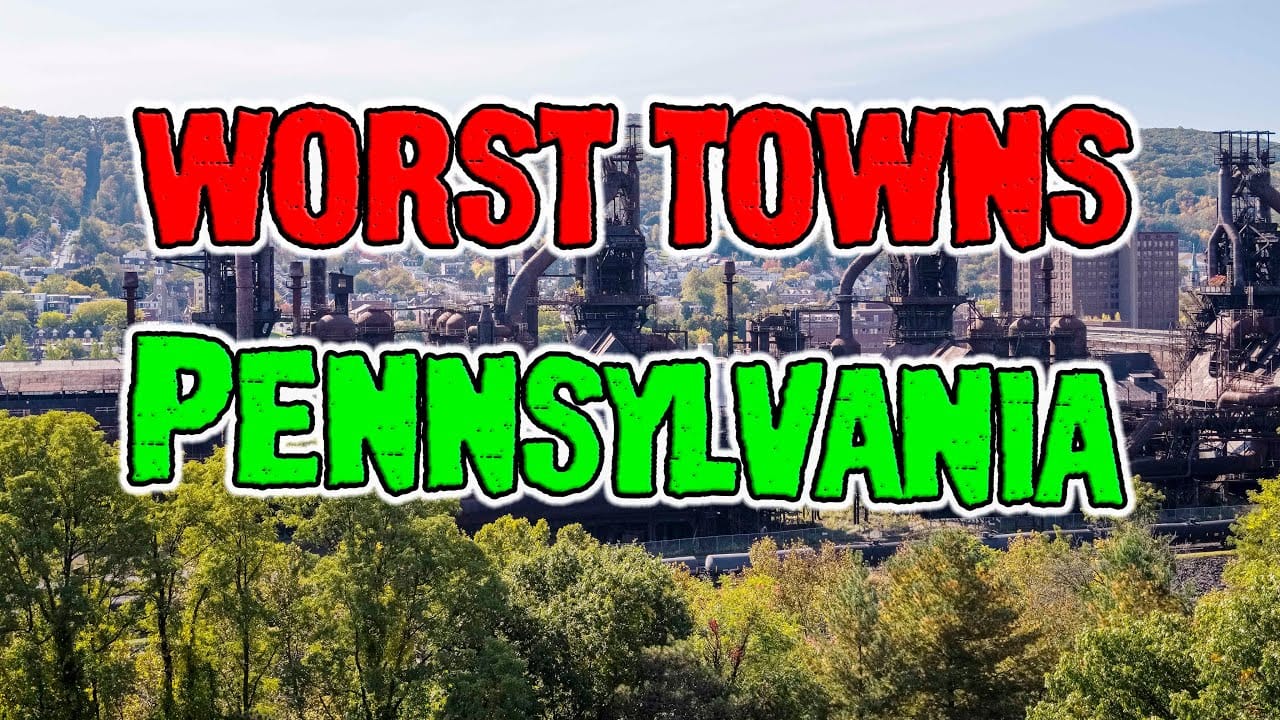Pennsylvania, the Keystone State, offers a mix of historical charm, vibrant cities, and picturesque countryside. However, like any state, it has places struggling with high crime rates, poverty, and declining economic opportunities. This article examines the five worst places to live in Pennsylvania, highlighting the challenges faced by these communities.
Important Considerations
- Data: This article relies on crime statistics, unemployment figures, poverty rates, and other socioeconomic indicators to support its analysis.
- Context: It’s important to note that these cities face historical and systemic challenges beyond the control of their residents.
- Perspective: While focusing on the struggles, it’s essential to acknowledge the resilience of the people in these communities and efforts to revitalize them.
1. McKees Rocks
- Overview: A borough in Allegheny County, McKees Rocks struggles with the highest crime rate in Pennsylvania. Its small population has to contend with significant challenges.
- High Crime Rates: Violent and property crime rates far exceed both state and national averages, creating a pervasive sense of insecurity among residents.
- Economic Decline: Loss of traditional industries had a devastating impact on McKees Rocks. The closure of steel mills and other manufacturing plants led to high unemployment and economic distress.
- Limited Opportunities: Lack of job prospects, particularly for young people, contributes to social problems and a cycle of poverty within the community.
2. Chester
- Overview: Situated in Delaware County, Chester grapples with deeply entrenched issues, earning it a reputation as one of the most dangerous cites in Pennsylvania and the entire country.
- Persistent Crime and Violence: Chester’s crime rates consistently outpace the national average. Violent crimes, including homicides, are alarmingly high.
- Struggling Economy and High Poverty: Limited economic opportunities and a high poverty rate plague Chester. The median household income is significantly below the state average.
- Legacy of Political Challenges: Chester’s history includes instances of political mismanagement and corruption, compounding the city’s problems and hindering revitalization efforts.
3. McKeesport
- Overview: Another Allegheny County city, McKeesport suffers from economic hardship and related safety concerns.
- Unemployment and Economic Distress: Like other former industrial hubs, McKeesport lost significant job opportunities, resulting in high unemployment and a struggling local economy.
- Safety Concerns: Elevated crime rates contribute to McKeesport’s challenging living conditions. While lower than McKees Rocks and Chester, crime statistics remain worrisome for residents.
- Declining Population and Housing Issues: McKeesport faces population decline, abandoned properties, and urban blight, further undermining its quality of life.
4. Yeadon
- Overview: A small borough in Delaware County, Yeadon faces issues with both property crime and violent crime.
- Property and Violent Crime Rates: Residents have a much higher-than-average chance of being a victim of crime.
- Socioeconomic Challenges: Yeadon contends with limited economic growth, poverty, and a lack of quality housing options.
- Limited Amenities: Despite its proximity to Philadelphia, Yeadon doesn’t offer the same range of amenities, which hampers its appeal to potential residents.
5. New Kensington
- Overview: New Kensington, in Westmoreland County, has seen better days. It struggles with an ongoing drug epidemic, economic challenges, and aging infrastructure.
- Drug Crisis and Impact on the Community: New Kensington is deeply affected by the opioid crisis and other substance abuse problems. Drug-related crimes and overdose deaths severely impact the community’s well-being.
- Economic Stagnation: Lack of new industries and job opportunities has led to economic hardship and decline, further exacerbating the challenges New Kensington faces.
- Aging Population and Infrastructure: New Kensington has a large elderly population, and its infrastructure requires significant investment and renewal.
Factors Contributing to the Decline of These Cities
While each city faces unique complexities, there are some common factors contributing to their struggles:
- Deindustrialization: The decline of Pennsylvania’s traditional industries like steel manufacturing hit many of these cities particularly hard, leading to job losses and economic distress.
- Suburbanization: Outflow of residents to surrounding suburbs, seeking safer environments and better opportunities, has eroded the tax base and resources of these cities.
- Systemic Issues: Underlying socioeconomic inequalities, limited access to quality education, and lack of sufficient investment contribute to the ongoing problems.
Important Note: Potential for Revitalization
Despite the challenges, it’s crucial to remember that these cities aren’t hopeless situations. Throughout Pennsylvania, there are community-led initiatives, redevelopment projects, and efforts to address the root causes of poverty and crime. While change takes time, there is potential for these cities to find paths towards revitalization.
Sources
To provide a balanced and factual analysis, this article draws from various reliable sources, including:
- FBI Crime Statistics: The FBI’s Uniform Crime Reporting (UCR) Program provides official crime data for cities across the U.S. (https://ucr.fbi.gov/)
- US Census Bureau: For demographic and socioeconomic data, the Census Bureau is invaluable. (https://www.census.gov/)
- Local and Regional News Outlets: News reports and investigations from local Pennsylvania newspapers often delve deeper into specific challenges and potential solutions faced by these communities.
- Academic and Policy Studies: Research papers and reports from universities and think tanks can shed light on the historical context and systemic issues surrounding urban decline.
Conclusion
This article provides an unvarnished look at the challenges faced by the most difficult places to live in Pennsylvania. By understanding the factors that contribute to the decline of these cities, we can gain better insight into the complexities of urban renewal and the need for systemic solutions that address poverty, crime, and lack of opportunity. While it highlights the struggles, it’s essential to remember the resilience of individuals living in these communities and their potential for revitalization.
Disclaimer
This article aims to present factual information and avoid stigmatizing any specific location. Cities are dynamic, and conditions can change over time. Remember, every community has its strengths, and it’s essential to approach these issues with sensitivity and a focus on finding solutions.



